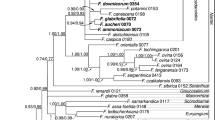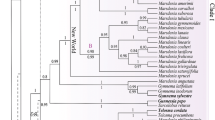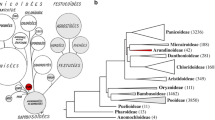Abstract
The phylogenetic status of the genus Atraphaxis and its relationship with woody Polygonum species is examined based on nrDNA ITS and two chloroplast regions (matK and rpl32-trnL(UAG)). Morphological and palynological studies for the selected taxa are also performed. Our results revealed that several woody Polygonum species (namely P. spinosum, P. aridum, P. dumosum, P. salicornioides, P. khajeh-jamali and P. botuliforme) endemic to Iran formed a distinct clade, and are nested within Atraphaxis. Atraphaxis ovczinnikovii, (=P. ovczinnikovii), was the first diverging lineage as sister to an assemblage of these taxa and the bulk of Atraphaxis species. Three other woody Polygonum species (P. afghanicum, P. paronychioides and P. thymifolium) were nested within herbaceous Polygonum species. Ochrea and pollen characteristics corroborated the phylogenetic results as well. Based on molecular and morphological evidence, we transferred the aforementioned six Polygonum species into Atraphaxis. The newly delimited genus Atraphaxis is comprised of three lineages, corresponding to three new sections: Atraphaxis, Polygonoides and Ovczinnikovia. The different position of A. botuliformis (=P. botuliforme) in nrDNA ITS and combined chloroplast DNA analyses indicated that it had possibly experienced the hybrid or introgression for a long time. Taxonomic descriptions for Atraphaxis and its sections as well as the diagnostic key to sections and species occurring in Iran, are presented.



Similar content being viewed by others
References
Acosta MC, Premoli AC (2010) Evidence of chloroplast capture in South American Nothofagus (subgenus Nothofagus, Nothofagaceae). Molec Phylogen Evol 54:235–242
Amiri N, Sharifnia F (2007) Revision of taxonomy of Polygonum sections in Iran by palynological characters (in Persian). Rostaniha 8:85–93
Bao B, Grabovskaya-Borodina AE (2003) Polygonaceae. In: Huang SD (ed) Flora of China 5. Science Press (Beijing) and Missouri Botanical (St. Louis), pp 328–333
Bao BJ, Li AR (1993) A study of the genus Atraphaxis in China and the system of Atraphaxideae (Polygonaceae). Acta Phytotax Sin 31:127–139
Brandbyge J (1993) Polygonaceae. In: Kubitzki K, Rohwer JC, Bittrich V (eds) The families and genera of vascular plants, vol 2. Springer-Verlag, Berlin, pp 531–544
Chukavina AP (1968) Polygonum-Polygonaceae. In: Ovchinnikov PN (ed) Flora Tadzhikskoi SSR III, 2nd edn. Leningrad, Izdatelstvo Akademii Nauk SSSR, pp 244–252
Cullen J (1967) Atraphaxis-Polygonaceae. In: Davis PH (ed) Flora of Turkey 2. Edinburgh University Press, Edinburgh, pp 266–267
Cunningham CW (1997) Can three incongruence tests predict when data should be combined? Molec Biol Evol 14:733–740
Doyle JJ, Doyle JL (1987) A rapid DNA isolation procedure for small quantities of fresh leaf tissue. Phytochem Bull 19:11–15
Eastwood A, Lazkov G, Newton A (2009) The red list of trees of central Asia. Fauna & Flora International, Cambridge
Edgar RC (2004) Muscle: multiple sequence alignment with high accuracy and high throughput. Nucl Acids Res 32:1792–1797
Erdtman G (1952) Pollen morphology and plant taxonomy, angiosperms. Almqvist and Wiksell, Stockholm
Farris JS, Kallersjo M, Kluge AG, Bult C (1995) Testing significance of incongruence. Cladistics 10:315–319
Fehrer J, Gemeinholzer B, Chrtek JJ, Bräutigam S (2007) Incongruent plastid and nuclear DNA phylogenies reveal ancient intergeneric hybridization in Pilosella hawkweeds (Hieracium, Cichorieae, Asteraceae). Molec Phylogen Evol 42:347–361
Felsenstein J (1985) Confidence limits on phylogenies: an approach using the bootstrap. Evolution 39:783–791
Galasso G, Banfi E, Mattia FD, Grassi F, Sgorbati S, Labra M (2009) Molecular phylogeny of Polygonum L. s.l. (Polygonoideae, Polygonaceae), focusing on European taxa: preliminary results and systematic considerations based on rbcL plastidial sequence data. Atti Soc Ital Sci Nat Mus Civico Storia Nat Milano 150:113–148
Haraldson K (1978) Anatomy and Taxonomy in Polygonaceae subfam. Polygonoideae Meisn. emend. Jaretzky, Acta University Upsalensis. Symb Bot Upsal 22:1–95
Hong SP (1995) Pollen morphology of Parapteropyrum and some putatively related genera (Polygonaceae-Atraphaxideae). Grana 34:153–159
Jackson HD, Steane DA, Potts BM, Vaillancourt RE (1999) Chloroplast DNA evidence for reticulate evolution in Eucalyptus (Myrtaceae). Molec Ecol 8:739–751
Khosravi A, Poormahdi S (2008) Polygonum khajeh-jamali (Polygonaceae), a new species from Iran. Ann Bot Fenn 45:477–480
Kim ST, Donoghue MJ (2008a) Molecular phylogeny of Persicaria (Persicarieae, Polygonaceae). Syst Bot 33:77–86
Kim ST, Donoghue MJ (2008b) Incongruence between cpDNA and nrITS trees indicates intensive hybridization within Eupersicaria (Polygonaceae). Amer J Bot 95:1122–1135
Kim ST, Sultan SE, Donoghue MJ (2008) Allopolyploid speciation in Persicaria (Polygonaceae): insights f from a low-copy nuclear region. Proc Natl Acad Sci USA 105:12370–12375
Komarov VL (1970) Polygonum-Polygonaceae. In: Komarov VL (ed) Flora of the USSR 5 (English translation) Moskva & Leningrad, pp 457–492
Kornkven AB, Watson LE, Estes JR (1999) Molecular phylogeny of Artemisia section Tridentatae (Asteraceae) based on chloroplast DNA restriction site variation. Syst Bot 24:69–84
Lamb Frye AS, Kron KA (2003) rbcL Phylogeny and character evolution in Polygonaceae. Syst Bot 28:326–332
Mabberley DJ (2008) The plant-book: a portable dictionary of the higher plants, 3rd edn. Cambridge University Press, Cambridge
Miller JS, Kamath A, Levin RA (2009) Do multiple tortoises equal a hare? The utility of nine noncoding plastid regions for species-level phylogenetics in tribe Lycieae (Solanaceae). Syst Bot 34:1–9
Mosaferi S, Keshavarzi M (2011) Micromorphological study of Polygonaceae tribes in Iran. Phytol Balcan 17:89–100
Mozaffarian V (1988) New species and new plant records from Iran. Iran J Bot 4:61–70
Mozaffarian V (2006) Studies on the flora of Iran, four species and a short note on an interesting Rubiaceae. Iran J Bot 12:107–108
Mozaffarian V (2012) A Revision of Polygonum L. sensu lato (Polygonaceae) in Iran. Iran J Bot 18:159–174
Navajes-Péres R, Herran Rdl, Gonalez GL, Jamilerna M, Lozano R, Rejon CR CR, Rejon MR (2005) The evolution of reproductive systems and sex-determination mechanisms within Rumex (Polygonaceae) inferred from nuclear and chloroplastidial sequences data. Molec Biol Evol 22:1929–1939
Nowicke JW, Skvarla JJ (1977) Pollen morphology and the relationship of the Plumbaginaceae, Polygonaceae and Primulaceae to the order Centrospermae, vol 37. Smithsonian Institution Press, Washington, pp 1–64
Nowicke JW, Skvarla JJ (1979) Pollen morphology: the potential influence in higher order systematic. Ann Missouri Bot Gard 66:633–700
Nylander JAA (2004) MrModeltest v2. Program distributed by the author. Evolutionary Biology Centre, Uppsala University
Ooi K, Endo Y, Yokoyama J, Murakami N (1995) Useful primer designs to amplify DNA fragment of the plastid gene matK from angiosperm plants. J Jap Bot 70:328–333
Page DM (2001) TreeView (Win32) Version 1.6.6. Available from: http://taxonomy.zoology.gla.ac.uk/rod/rod.html/
Pavlov NV (1970) Atraphaxis-Polygonaceae. In: Komarov VL (ed) Flora of the USSR 5 (English translation). Moskva & Leningrad, pp 392–411
Posada D, Buckley T (2004) Model selection and model averaging in phylognetics: advantages of Akaike information criterion and Bayesian approaches over likelihood ratio tests. Syst Biol 53:793–808
Punt W, Hoen PP, Nilsson S, Thomas L (2007) Glossary of pollen and spore terminology. Rev Palaeobot Palynol 143:1–81
Rajapov M (2002) Threatened flora and fauna. In: Magin C, Mickelburgh S (eds) Biodiversity strategy and action plan of Turkmenistan. Ministry of Nature Protection of Turkmenistan, Ashgabat, p 112
Rambaut A, Drummond AJ (2007) TRACER version 1.5. Available: http://beast.bio.ed.ac.uk/Tracer. Accessed 05 Mar 2012
Rechinger KH, Schiman-Czeika H (1968) Polygonaceae. In: Rechinger KH (ed) Flora Iranica 56. Akademische Druck- u. Verlagsanstalt, Graz, pp 36–46
Rieseberg LH, Soltis DE (1991) Phylogenetic consequences of cytoplasmic gene flow in plants. Evol Trends Pl 5:65–84
Ronquist F, Huelsenbeck JP (2003) MrBayes 3: Bayesian phylogenetic inference under mixed models. Bioinformatics 19:1572–1574
Ronse Decraene LP, Akeroyd JR (1988) Generic limits in Polygonum and related genera (Polygonaceae) on the Basis of floral Characters. Bot J Linn Soc 98:321–371
Ronse Decraene LP, Hong SP, Smets EF (2000) Systematic significance of fruit morphology and anatomy in tribes Persicarieae and Polygoneae (Polygonaceae). Bot J Linn Soc 134:301–337
Sanchez A, Kron KA (2008) Phylogenetics of Polygonaceae with an emphasis on the evolution of Eriogonoideae. Syst Bot 33:87–96
Sanchez A, Schuster TM, Kron KA (2009) A large-scale phylogeny of Polygonaceae based on molecular data. Int J Pl Sci 170:1044–1055
Sanchez A, Schuster TM, Burke JM, Kron KA (2011) Taxonomy of Polygonoideae (Polygonaceae): a new tribal classification. Taxon 60:151–160
Schuster TM, Wilson KL, Kron KA (2011a) Phylogenetic relationships of Muehlenbeckia, Fallopia and Reynoutria (Polygonaceae) investigated with chloroplast and nuclear sequence data. Int J Pl Sci 172:1053–1066
Schuster TM, Reveal JL, Kron KA (2011b) Phylogeny of Polygoneae (Polygonaceae: Polygonoideae). Taxon 60:1653–1666
Schuster TM, Setaro SD, Kron KA (2013) Age estimates for the Buckwheat family Polygonaceae based on sequence data calibrated by fossils and with a focus on the Amphi-Pacific Muehlenbeckia. PLoS One 8:e61261
Shaw J, Lickey EB, Schilling EE, Small RL (2007) Comparison of whole chloroplast genome sequences to choose noncoding regions for phylogenetic studies in angiosperms: the tortoise and the hare III. Amer J Bot 94:275–288
Shimodaira H, Hasegawa M (1999) Multiple comparisons of log-likelihoods with applications to phylogenetic inference. Molec Biol Evol 16:1114–1116
Silvestro D, Michalak I (2011) raxmlGUI: a graphical front-end for RAxML. Organisms Diversity Evol 12:335–337
Sun Y, Zhang M (2012) Molecular phylogeny of tribe Atraphaxideae (Polygonaceae) evidenced from five cpDNA genes. J Arid Land 4:180–190
Swofford DL (2002) Phylogenetic analysis using parsimony (* and other methods). Version. 4. Sinauer Associates, Sunderland, Massachusetts, USA
Tavakkoli S, Kazempour Osaloo S, Maassoumi AA (2010) The phylogeny of Calligonum and Pteropyrum (Polygonaceae) based on nuclear ribosomal DNA ITS and chloroplast trnL-F sequences. Iran J Biotechnol 8:1–15
Tavakkoli S, Kazempour Osaloo S, Mozaffarian V, Maassoumi AA (2013) Atraphaxis radkanensis, a new species of Atraphaxis sect. Tragopyrum (Polygonaceae) from Iran. Ann Bot Fenn 50:372–374
Tavakkoli S, Kazempour Osaloo S, Mozaffarian V (2014) Atraphaxis binaludensis (Polygonaceae), a new species from northeastern Iran. Iran J Bot 20:1–4
Tian XM, Luo J, Wang A, Mao K, Liu J (2011) On the origin of the woody Buckwheat Fagopyrum tibeticum (=Parapteropyrum tibeticum) in the Qinghai-Tibetan Plateau. Molec Phylogen Evol 61:515–520
Tsitrone A, Kirkpatrick M, Levin DA (2003) A model for chloroplast capture. Evolution 57:1776–1782
Van Raamsdonck LWJ, Smiech MP, Sandbrink JM (1997) Introgression explains incongruence between nuclear and chloroplast DNA-based phylogenies in Allium section Cepa. Bot J Linn Soc 123:91–108
White TJ, Bruns T, Lee S, Taylor J (1990) Amplification and direct sequencing of fungal ribosomal RNA genes for phylogenetics. In: Innis M, Gelfand D, Sninsky J, White T (eds) PCR protocols: a guide to methods and applications. Academic Press, San Diego, pp 315–322
Wolfe AD, Elisens WJ (1995) Evidence of chloroplast capture and pollen mediated gene flow in Penstemon sect. Peltanthera (Scropulariaceae). Syst Bot 20:395–412
Yasmin G, Khan MA, Shaheen N (2010) Pollen morphology of selected Polygonum L. Species (Polygonaceae) from Pakistan and its taxonomic significance. Pakistan J Bot 42:3693–3703
Yurtseva OV, Troitsky AV, Bobrova VK, Voylokova VN (2010) On taxonomical revision of Polygonum s. str. (Polygonaceae): phylogenetic and morphological data. Bot Zhurn 95:226–247
Yurtseva OV, Kuznetsova OI, Severova E E, Troitsky AV (2012a) Molecular phylogeny and morphology of Polygonum L. and Atraphaxis L. (Polygoneae, Polygonaceae). Molecular phylogenetics: contributions to the 3rd Moscow international conference “Molecular phylogenetics”, Moscow, Russia, July 31–Aug 4, 2012. Torus Press, Moscow, p 38
Yurtseva OV, Kuznetsova OI, Severova EE, Troitsky AV (2012b) Taxonomy and morphology of Atraphaxis (Polygoneae, Polygonaceae). Caryophyllales: new insights into the phylogeny, systematics and morphological evolution of the order. In: Proceedings of the symposium held on 24–27 Sept 2012 at Moscow MV Lomonosov State University. Grif & Co, Tula, pp 114–118
Yurtseva OV, Severova EE, Bovina IYu (2014) Pollen morphology and taxonomy of Atraphaxis (Polygoneae, Polygonaceae). Pl Syst Evol 300:749–766
Acknowledgments
The present study was financially supported by Tarbiat Modares University and represents partial fulfilment of the requirements for the PhD degree by the first author. Authors thank Dr. Yadollahpour for editing the text. We thank anonymous referees for their useful comments to improve the manuscript.
Author information
Authors and Affiliations
Corresponding author
Rights and permissions
About this article
Cite this article
Tavakkoli, S., Kazempour Osaloo, S., Mozaffarian, V. et al. Molecular phylogeny of Atraphaxis and the woody Polygonum species (Polygonaceae): taxonomic implications based on molecular and morphological evidence. Plant Syst Evol 301, 1157–1170 (2015). https://doi.org/10.1007/s00606-014-1140-7
Received:
Accepted:
Published:
Issue Date:
DOI: https://doi.org/10.1007/s00606-014-1140-7




